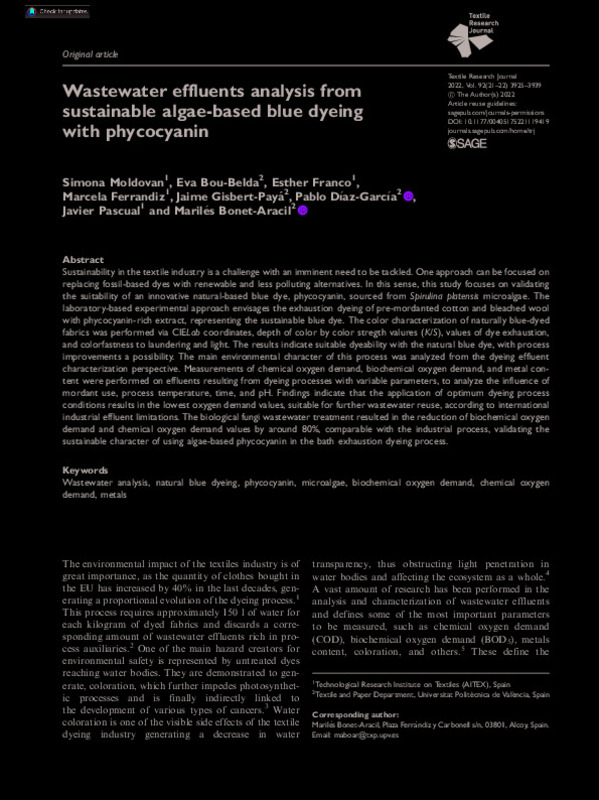JavaScript is disabled for your browser. Some features of this site may not work without it.
Buscar en RiuNet
Listar
Mi cuenta
Estadísticas
Ayuda RiuNet
Admin. UPV
Wastewater effluents analysis from sustainable algae-based blue dyeing with phycocyanin
Mostrar el registro sencillo del ítem
Ficheros en el ítem
| dc.contributor.author | Moldovan, Simona
|
es_ES |
| dc.contributor.author | Bou-Belda, Eva
|
es_ES |
| dc.contributor.author | Franco, Esther
|
es_ES |
| dc.contributor.author | Ferrándiz, Marcela
|
es_ES |
| dc.contributor.author | Gisbert Paya, Jaime
|
es_ES |
| dc.contributor.author | Díaz-García, Pablo
|
es_ES |
| dc.contributor.author | Pascual, Javier
|
es_ES |
| dc.contributor.author | BONET-ARACIL, MARILÉS
|
es_ES |
| dc.date.accessioned | 2023-09-27T18:01:58Z | |
| dc.date.available | 2023-09-27T18:01:58Z | |
| dc.date.issued | 2022-11 | es_ES |
| dc.identifier.issn | 0040-5175 | es_ES |
| dc.identifier.uri | http://hdl.handle.net/10251/197249 | |
| dc.description.abstract | [EN] Sustainability in the textile industry is a challenge with an imminent need to be tackled. One approach can be focused on replacing fossil-based dyes with renewable and less polluting alternatives. In this sense, this study focuses on validating the suitability of an innovative natural-based blue dye, phycocyanin, sourced from Spirulina platensis microalgae. The laboratory-based experimental approach envisages the exhaustion dyeing of pre-mordanted cotton and bleached wool with phycocyanin-rich extract, representing the sustainable blue dye. The color characterization of naturally blue-dyed fabrics was performed via CIELab coordinates, depth of color by color stregth valures (K/S), values of dye exhaustion, and colorfastness to laundering and light. The results indicate suitable dyeability with the natural blue dye, with process improvements a possibility. The main environmental character of this process was analyzed from the dyeing effluent characterization perspective. Measurements of chemical oxygen demand, biochemical oxygen demand, and metal content were performed on effluents resulting from dyeing processes with variable parameters, to analyze the influence of mordant use, process temperature, time, and pH. Findings indicate that the application of optimum dyeing process conditions results in the lowest oxygen demand values, suitable for further wastewater reuse, according to international industrial effluent limitations. The biological fungi wastewater treatment resulted in the reduction of biochemical oxygen demand and chemical oxygen demand values by around 80%, comparable with the industrial process, validating the sustainable character of using algae-based phycocyanin in the bath exhaustion dyeing process. | es_ES |
| dc.description.sponsorship | The author(s) disclosed receipt of the following financial support for the research, authorship, and/or publication of this article: The authors acknowledge the support of this study to the research projects funded by the European Commission, SEACOLORS, "Demonstration of new natural dyes from algae as substitution of synthetic dyes actually used by textile industries," (grant number LIFE13 ENV/ES/000445) within the LIFE 2013 "Environment 300 Policy and Governance project application" program and GREENCOLOR "Study of the application of natural colorants in dyeing and printing processes in the textile industry," in the framework of the local call, Valencian, IVACE 2017, reference number: IMDEEA/2017/37. | es_ES |
| dc.language | Inglés | es_ES |
| dc.publisher | SAGE Publications | es_ES |
| dc.relation.ispartof | Textile Research Journal | es_ES |
| dc.rights | Reconocimiento - No comercial (by-nc) | es_ES |
| dc.subject | Wastewater analysis | es_ES |
| dc.subject | Natural blue dyeing | es_ES |
| dc.subject | Phycocyanin | es_ES |
| dc.subject | Microalgae | es_ES |
| dc.subject | Biochemical oxygen demand | es_ES |
| dc.subject | Chemical oxygen demand | es_ES |
| dc.subject | Metals | es_ES |
| dc.subject.classification | INGENIERIA TEXTIL Y PAPELERA | es_ES |
| dc.title | Wastewater effluents analysis from sustainable algae-based blue dyeing with phycocyanin | es_ES |
| dc.type | Artículo | es_ES |
| dc.identifier.doi | 10.1177/00405175221119419 | es_ES |
| dc.relation.projectID | info:eu-repo/grantAgreement/EC//LIFE13 ENV%2FES%2F000445/ | es_ES |
| dc.relation.projectID | info:eu-repo/grantAgreement/IVACE//IMDEEA%2F2017%2F37//GREENCOLOR/ | es_ES |
| dc.rights.accessRights | Abierto | es_ES |
| dc.contributor.affiliation | Universitat Politècnica de València. Escuela Politécnica Superior de Alcoy - Escola Politècnica Superior d'Alcoi | es_ES |
| dc.description.bibliographicCitation | Moldovan, S.; Bou-Belda, E.; Franco, E.; Ferrándiz, M.; Gisbert Paya, J.; Díaz-García, P.; Pascual, J.... (2022). Wastewater effluents analysis from sustainable algae-based blue dyeing with phycocyanin. Textile Research Journal. 92(21-22):3925-3939. https://doi.org/10.1177/00405175221119419 | es_ES |
| dc.description.accrualMethod | S | es_ES |
| dc.relation.publisherversion | https://doi.org/10.1177/00405175221119419 | es_ES |
| dc.description.upvformatpinicio | 3925 | es_ES |
| dc.description.upvformatpfin | 3939 | es_ES |
| dc.type.version | info:eu-repo/semantics/publishedVersion | es_ES |
| dc.description.volume | 92 | es_ES |
| dc.description.issue | 21-22 | es_ES |
| dc.relation.pasarela | S\475386 | es_ES |
| dc.contributor.funder | European Commission | es_ES |
| dc.contributor.funder | Institut Valencià de Competitivitat Empresarial | es_ES |
| upv.costeAPC | 900 | es_ES |








